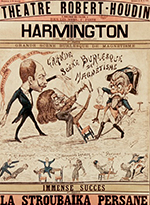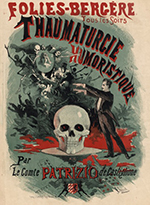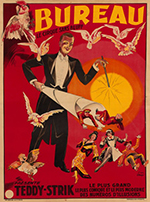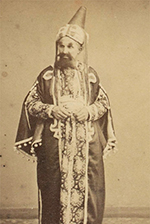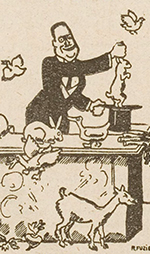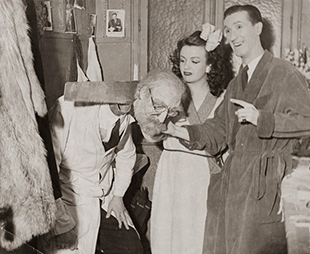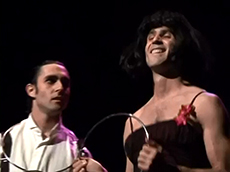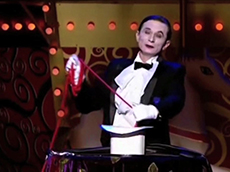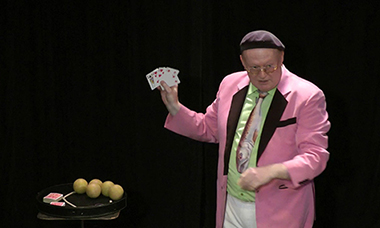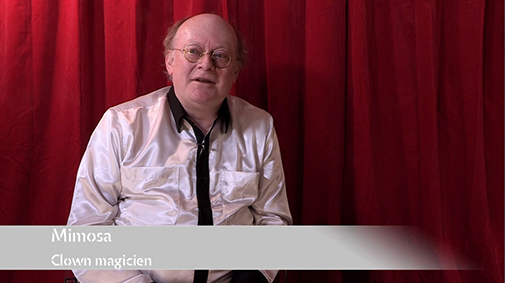by Frédéric Tabet
Comic magic draws from all the traditional categories of modern magic the ingredients that will serve both the undeniable magic effect and laughter. It relies on a form of presentation rather than on a pre-established representation framework or a particular technique.
It seems paradoxical to characterise a form of "comic" magic. Because the magic effect, whatever its presentation, often leads to laughter. Creator of unexplainable, unpredictable events, the magician thwarts the spectator's expectation or reasoning, whose reaction is often laughter! Some other tricks cause disbelief and make you smile when the magician mechanically applies a principle to an inappropriate object. So, when he irons a ball, which is then printed on a support, or when he blows a little hard on the knot, which comes off the rope... This confrontation of a reasoning on an unexpected support makes people laugh.
Borrowing from tradition
All the traditional categories of magic can produce comic numbers, from close-up with the Australian David Williamson (1942-), to the great illusion with the Dutch Scott & Muriel, without forgetting the manipulation numbers of the British Cardini (Richard Valentine Pitchford, 1895-1973). The comic dimension is born from the techniques used in the general presentation of effects: thus, the comic aspects found in words, in local expressions or accents, the comic elements of gestures and mimics, the comic of situation, including repetition. Some tricks are particularly suitable for comic narrative modes, burlesque entanglements or vaudeville-type misunderstandings. Thus, the tricks based on the repetitiveness of the same effect such as the multiplication of bottles by Hugues Protat or the "house-bound" cards of the Dutchman Fred Kaps (1926-1980). Those that rely on variations like Cardini's "diminishing cards" or on knowledge gaps between people on stage and those in the room, such as in the routine of Slydini's "balls". But the comic presentation also reflects a shift from conventional traditions.
Unexpected objects
To surprise us, the magician can use unexpected props, borrowed from worlds outside the realm of prestidigitation. Some are stolen from the scenic environment: Gaëtan Bloom's microphone, the camera of the English television magician Paul Daniels, the projectors at Chris Torrente's house, the loudspeakers or the foam machine of the German magician Topas. In the real world of everyday life, the comic magician entraps tires instead of rings, displays underwear tied between two scarves instead of the vanished scarf or replaces the expected dove with a roasted chicken or a mechanical bird…
The eccentrics
Many comic acts are developed around a character who plays against type. The contemporary Ukrainian Voronin, the French mime and magician Mac Ronay (1913-2004) or the Americans Great Tomsoni & Co, manage with composure and without a word the blundering and treacherous material. On the other hand, it is in an uninterrupted speech that the British Tommy Cooper (1931-1984) or the American Tom Mullica produce a succession of hilarious effects. Others, struggling with a world that resists them, provoke laughter in their efforts to perform their tricks properly, such as the French-Spanish comedian Garcimore or Raymond Raymondson, Otto Wessely or Topper Martyn. According to Thomas Fröschle [Topas], this type of magician falls neither into the category of "killers", masters of their effects, nor that of "witnesses", whose universe coexists with magical phenomena, but rather of "victims", subjected to the effects that redirect their actions.
The parodists
Other comical effects result from a shift in the magician's costume, breaking with the usual dress codes. The orientalist fashion of the 19th century, embodied by the "magician" Imro Fox (1862-1910), found glory in the first half of the 20th century with the "mad scientist" of Indian origin Ali Bongo (1929-2009) or the Americans Milo and Roger. Paulus and Anja Philippart have fantastic silhouettes when others like Mimosa, Michael Vadini, and more generally the transformists, use cross-dressing. As a driving force of comic magic, outrage does not aim to summon or strengthen an imaginary world, but to denounce its fictitious aspect.
The dissident rebels
Some explore other comic worlds. Born in the 1960s, the Americans Rudy Coby or Kevin James were inspired by the comic strip and comics books. Others play characters from the burlesque cinematographic universe, such as the Italian Carmelo Cacciato, or even from animated films. Sylvester the Jester takes up the body deformations of the Warner Bros. cartoons, the French Mikael Szanyiel and Chris Torrente borrow from the adventures of the orchestra conductors popularised in Tex Avery's cartoons at the MGM.
The success and endurance of comic magic puts a new twist on established codes. Every act exacerbates the effects or postures of the classical magician to the point of derision. These recurring charges challenge the aesthetics of contemporary magic and open up new avenues for reflection.
Interview



